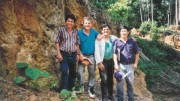Roscoe Postle Associates (RPA), one of the world’s leading mining consulting firms, presented at the recent Mineral Resource Analyst Group session in Toronto on “potential mining pitfalls”. The Northern Miner caught up with RPA’s president and CEO Deborah McCombe on the sidelines of the session to chat about disclosure standards, and what investors should look for in National Instrument 43-101 reports.
The Northern Miner: From a regulatory standpoint, how has RPA’s advice to industry changed over the last 30 years?
Deborah McCombe: Predominately RPA is known for their resource and reserve work, and that’s the area we’ve specialized in over the years. I would say from a regulatory viewpoint there’s more disclosure in the 43-101 reports about how you do the resource and the reserves, and what information is involved in that.
TNM: The Canadian Securities Administrators introduced the National Instrument 43-101 disclosure standards in February 2011 after the Bre-X scandal, and it revised those standards in June 2011. Could you talk about how the mining industry has changed with these standards?
DM: Overall, there is more transparency. It is a lot better in the area of being able to compare different projects in different parts of the world, because it is telling you that all the information that needs to be disclosed in a 43-101 report is in all the reports from the different companies.
TNM: The 43-101 is the Canadian standard. How likely is it that we will get a global standard for mineral disclosure?
DM: We are moving towards that direction. There’s a group called CRIRSCO, it’s an international resource and reserves reporting standards committee, and they have representatives from groups from Canada, the U.K., Australasia, South Africa, the U.S., Chile and also from Russia now. So these groups are all getting together and standardizing the mineral resource and mineral reserve definitions, as well as resources for prefeasibility and feasibility studies.
TNM: When would this global standard likely come into effect?
DM: What’s happening now is that each of the jurisdictions are updating their resource and reserve codes, and they are already incorporating these definitions. So already, the JORC code was updated in the end of 2012, and the CIM definitions in Canada were updated in 2014.
TNM: What are the benefits of having a global standard for disclosure?
DM: I think once again it is investor confidence, which is really important because you are having a qualified person (QP) — or competent person — involved in the disclosure. All the codes that provide guidance on how to do resource and reserve estimation are becoming standardized around the world, so the disclosure should be standardized as well.
TNM: Let’s talk a bit about the QP. Have you been seeing qualified persons that are not competent signing off on technical reports?
DM: It is a self-assessment where some people may feel with their years of experience that they may have the qualifications to prepare a mineral resource estimate or technical report. But now we are taking the approach that you have to be judged by your peers, if it comes into question at all whether you are qualified or not in that area. Also, as part of the technical report, you have to disclose what your relevant experiences are, whether it is resource estimation or exploration. So you should be a QP for that area for that stage of a project.
TNM: How many years of experience should a QP have?
DM: You would actually have to have a minimum of five years of experience, but that experience really should be relevant to the aspect that you are reporting on.
TNM: You mentioned in your presentation that just because a company files a technical report on SEDAR, it doesn’t mean that regulators have reviewed it, because there are only six people in Canada looking at these reports. Is that correct?
DM: There are six professionals across Canada looking at the reports, three in B.C., two in Ontario and one in Quebec right now, and that’s why there are a lot of technical reports out there that are not being reviewed by the regulators.
TNM: Do you expect that to change? Do you see the regulators hiring more professionals to review the reports?
DM: It is becoming more and more important that there are continuous disclosure reviews of a company’s legal as well as accounting, and in the case of mining companies, technical disclosure. So every three to five years the Ontario Securities Commission hopes to review all of their mining issuers and provide comment.
TNM: You mentioned in your talk that the OSC recently found that 40% of the technical reports that it recently looked at were not compliant. Do you believe the disclosure standards are effective, or do we need more regulation in the industry?
DM: I think about what it is: Are there educational aspects to it? People have to understand more and more what their requirements are in the technical disclosure. Hopefully, with this kind of educational process that the OSC has done, we will see more and more mining companies comply with the requirements.
TNM: How likely is it that a Bre-X type scandal could occur with the revised 43-101 disclosure standards in place?
DM: You can’t prevent fraud. If someone is going to commit a fraud they will find a way to do it, no matter how much disclosure you have out there.
TNM: So if an investor is looking at a mineral resource, what should they look for in terms of potential pitfalls?
DM: Some of the topics we covered today will be hard to find in the 43-101 technical reports for an individual investor looking at those. But they should look at the QP, as all of us mentioned, and looking at the relevant experience of the qualified person. That’s the key thing that people should look at.
(During the presentation RPA also mentioned that investors could look at the cut-off grade for a resource estimate. The lower the cut-off grade, the higher the ounces or pounds in a resource estimate, which could be misleading. The firm adds that an open-pit resource estimate should be constrained in a pit and that an underground resource should be continuous.)



Be the first to comment on "Interview: RPA’s Deborah McCombe on corporate disclosure’s past, present and future"